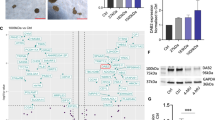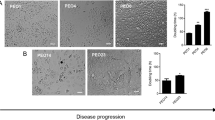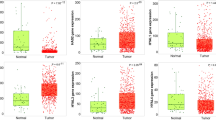Abstract
The assembly of pericellular matrix containing hyaluronan (HA) and versican has been shown to be a pre-requisite for proliferation and migration of mesenchymal cells. In this study, we investigated whether treatment with recombinant versican could induce the formation of a pericellular matrix by ovarian cancer cells (OVCAR-3, OVCAR-5, and SKOV-3) and promote their motility, invasion, and adhesion to peritoneal cells in vitro. We also determined whether versican-induced pericellular matrix formation and metastatic cancer cell behavior could be blocked by small HA oligosaccharides. Only combined treatment with recombinant versican and HA resulted in pericellular matrix formation by OVCAR-5 and SKOV-3 but not by OVCAR-3 cells, which lack the HA receptor, CD44. The motility of OVCAR-5 and SKOV-3 cells was significantly increased in scratch wound and chemotaxis assays following treatment with recombinant versican and HA. Versican and HA also promoted invasion of SKOV-3 and OVCAR-5 cells but had no effect on OVCAR-3 cells. We have demonstrated that exogenous HA significantly increased OVCAR-5 and SKOV-3 adhesion to peritoneal cells but adhesion was not further increased by versican treatment. Small HA oligomers (6–10 disaccharides) were able to significantly block formation of pericellular matrix by OVCAR-5 cells, as well as the increased motility and invasion induced by recombinant versican. HA oligomers also significantly blocked OVCAR-5 adhesion to peritoneal cells both in the presence and absence of exogenous HA. The dependence of CD44 for the versican and HA mediated effects were demonstrated by the inhibition of pericellular matrix formation as well as motility and invasion of OVCAR-5 cells following treatment with CD44 neutralizing antibody in the presence of versican and HA. We conclude that the acquisition of a HA/versican pericellular matrix by ovarian cancer cells increases their metastatic potential. HA oligomers can block this mechanism and are promising inhibitors of ovarian cancer dissemination.








Similar content being viewed by others
Abbreviations
- BSA:
-
Bovine serum albumin
- CM:
-
Conditioned media
- ECM:
-
Extracellular matrix
- EHS:
-
Engelbreth-Holm-Swarm
- FBS:
-
Fetal bovine serum
- FIGO:
-
Federation of Gynecologist and Obstetricians
- ERK:
-
Extracellular signal-regulated kinase
- HA:
-
Hyaluronan
- Hase:
-
Hyaluronidase
- MAPK:
-
Mitogen-activated protein kinase
- PI 3:
-
Phosphatidylinositol 3
References
Stewart BW (2003) WHO world cancer report. Lyon, France
Jemal A, Siegel R, Ward E et al (2009) Cancer statistics, 2009. CA Cancer J Clin 59(4):225–249
Doig T, Monaghan H (2006) Sampling the omentum in ovarian neoplasia: when one block is enough. Int J Gynecol Cancer 16(1):36–40
Liotta LA, Kohn EC (2001) The microenvironment of the tumour-host interface. Nature 411(6835):375–379
Zigrino P, Loffek S, Mauch C (2005) Tumor-stroma interactions: their role in the control of tumor cell invasion. Biochimie 87(3–4):321–328
Ricciardelli C, Rodgers RJ (2006) Extracellular matrix of ovarian tumors. Semin Reprod Med 24(4):270–282
Gardner MJ, Jones LM, Catterall JB et al (1995) Expression of cell adhesion molecules on ovarian tumour cell lines and mesothelial cells, in relation to ovarian cancer metastasis. Cancer Lett 91(2):229–234
Gardner MJ, Catterall JB, Jones LM et al (1996) Human ovarian tumour cells can bind hyaluronic acid via membrane CD44: a possible step in peritoneal metastasis. Clin Exp Metastasis 14(4):325–334
Wilson KE, Bartlett JM, Miller EP et al (1999) Regulation and function of the extracellular matrix protein tenascin-C in ovarian cancer cell lines. Br J Cancer 80(5–6):685–692
Strobel T, Cannistra SA (1999) Beta1-integrins partly mediate binding of ovarian cancer cells to peritoneal mesothelium in vitro. Gynecol Oncol 73(3):362–367
Anttila MA, Tammi RH, Tammi MI et al (2000) High levels of stromal hyaluronan predict poor disease outcome in epithelial ovarian cancer. Cancer Res 60(1):150–155
Voutilainen K, Anttila M, Sillanpaa S et al (2003) Versican in epithelial ovarian cancer: relation to hyaluronan, clinicopathologic factors and prognosis. Int J Cancer 107(3):359–364
Freedman RS, Deavers M, Liu J et al (2004) Peritoneal inflammation––a microenvironment for epithelial ovarian cancer (EOC). J Transl Med 2(1):23
Salani R, Neuberger I, Kurman RJ et al (2007) Expression of extracellular matrix proteins in ovarian serous tumors. Int J Gynecol Pathol 26(2):141–146
Kenny HA, Kaur S, Coussens LM et al (2008) The initial steps of ovarian cancer cell metastasis are mediated by MMP-2 cleavage of vitronectin and fibronectin. J Clin Invest 118(4):1367–1379
Heyman L, Kellouche S, Fernandes J et al (2008) Vitronectin and its receptors partly mediate adhesion of ovarian cancer cells to peritoneal mesothelium in vitro. Tumour Biol 29(4):231–244
Toole BP (2004) Hyaluronan: from extracellular glue to pericellular cue. Nat Rev Cancer 4(7):528–539
Tammi MI, Day AJ, Turley EA (2002) Hyaluronan and homeostasis: a balancing act. J Biol Chem 277(7):4581–4584
Hiltunen EL, Anttila M, Kultti A et al (2002) Elevated hyaluronan concentration without hyaluronidase activation in malignant epithelial ovarian tumors. Cancer Res 62(22):6410–6413
Boregowda RK, Appaiah HN, Siddaiah M et al (2006) Expression of hyaluronan in human tumor progression. J Carcinog 5:2
Jojovic M, Delpech B, Prehm P et al (2002) Expression of hyaluronate and hyaluronate synthase in human primary tumours and their metastases in scid mice. Cancer Lett 188(1–2):181–189
Yeo TK, Nagy JA, Yeo KT et al (1996) Increased hyaluronan at sites of attachment to mesentery by CD44-positive mouse ovarian and breast tumor cells. Am J Pathol 148(6):1733–1740
Catterall JB, Jones LM, Turner GA (1999) Membrane protein glycosylation and CD44 content in the adhesion of human ovarian cancer cells to hyaluronan. Clin Exp Metastasis 17(7):583–591
Casey RC, Skubitz AP (2000) CD44 and beta1 integrins mediate ovarian carcinoma cell migration toward extracellular matrix proteins. Clin Exp Metastasis 18(1):67–75
Lancaster JM, Dressman HK, Clarke JP et al (2006) Identification of genes associated with ovarian cancer metastasis using microarray expression analysis. Int J Gynecol Cancer 16(5):1733–1745
Bignotti E, Tassi RA, Calza S et al (2007) Gene expression profile of ovarian serous papillary carcinomas: identification of metastasis-associated genes. Am J Obstet Gynecol 196(3):245 e1–245 e11
Bast RC (2004) Early detection of ovarian cancer: new technologies in pursuit of a disease that is neither common nor rare. Trans Am Clin Climatol Assoc 115:233–248
Wight TN (2002) Versican: a versatile extracellular matrix proteoglycan in cell biology. Curr Opin Cell Biol 14(5):617–623
Ricciardelli C, Sakko AJ, Ween MP et al (2009) The biological role and regulation of versican levels in cancer. Cancer Metastasis Rev 28:233–245
Ricciardelli C, Mayne K, Sykes PJ et al (1998) Elevated levels of versican but not decorin predict disease progression in early-stage prostate cancer. Clin Cancer Res 4(4):963–971
Ricciardelli C, Brooks JH, Suwiwat S et al (2002) Regulation of stromal versican expression by breast cancer cells and importance to relapse-free survival in patients with node-negative primary breast cancer. Clin Cancer Res 8(4):1054–1060
Hanekamp EE, Gielen SC, Smid-Koopman E et al (2003) Consequences of loss of progesterone receptor expression in development of invasive endometrial cancer. Clin Cancer Res 9(11):4190–4199
Suwiwat S, Ricciardelli C, Tammi R et al (2004) Expression of extracellular matrix components versican, chondroitin sulfate, tenascin, and hyaluronan, and their association with disease outcome in node-negative breast cancer. Clin Cancer Res 10(7):2491–2498
Pukkila MJ, Kosunen AS, Virtaniemi JA et al (2004) Versican expression in pharyngeal squamous cell carcinoma: an immunohistochemical study. J Clin Pathol 57(7):735–739
Pirinen R, Leinonen T, Bohm J et al (2005) Versican in nonsmall cell lung cancer: relation to hyaluronan, clinicopathologic factors, and prognosis. Hum Pathol 36(1):44–50
Kodama J, Hasengaowa, Kusumoto T et al (2007) Versican expression in human cervical cancer. Eur J Cancer 43(9):1460–1466
Kodama J, Hasengaowa, Kusumoto T et al (2007) Prognostic significance of stromal versican expression in human endometrial cancer. Ann Oncol 18(2):269–274
Pukkila M, Kosunen A, Ropponen K et al (2007) High stromal versican expression predicts unfavourable outcome in oral squamous cell carcinoma. J Clin Pathol 60(3):267–272
Casey RC, Oegema TR Jr, Skubitz KM et al (2003) Cell membrane glycosylation mediates the adhesion, migration, and invasion of ovarian carcinoma cells. Clin Exp Metastasis 20(2):143–152
Lu KH, Patterson AP, Wang L et al (2004) Selection of potential markers for epithelial ovarian cancer with gene expression arrays and recursive descent partition analysis. Clin Cancer Res 10(10):3291–3300
Evanko SP, Angello JC, Wight TN (1999) Formation of hyaluronan- and versican-rich pericellular matrix is required for proliferation and migration of vascular smooth muscle cells. Arterioscler Thromb Vasc Biol 19(4):1004–1013
Ricciardelli C, Russell DL, Ween MP et al (2007) Formation of hyaluronan- and versican-rich pericellular matrix by prostate cancer cells promotes cell motility. J Biol Chem 282(14):10814–10825
Zeng C, Toole BP, Kinney SD et al (1998) Inhibition of tumor growth in vivo by hyaluronan oligomers. Int J Cancer 77(3):396–401
Ghatak S, Misra S, Toole BP (2002) Hyaluronan oligosaccharides inhibit anchorage-independent growth of tumor cells by suppressing the phosphoinositide 3-kinase/Akt cell survival pathway. J Biol Chem 277(41):38013–38020
Ward JA, Huang L, Guo H et al (2003) Perturbation of hyaluronan interactions inhibits malignant properties of glioma cells. Am J Pathol 162(5):1403–1409
LeBaron RG, Zimmermann DR, Ruoslahti E (1992) Hyaluronate binding properties of versican. J Biol Chem 267(14):10003–10010
Ween MP, Lokman NA, Hoffmann P et al (2010) Transforming growth factor beta-induced protein secreted by peritoneal cells increases the metastatic potential of ovarian cancer cells. Int J Cancer. doi:10.1002/ijc.25494
Knudson W, Knudson CB (1991) Assembly of a chondrocyte-like pericellular matrix on non-chondrogenic cells. Role of the cell surface hyaluronan receptors in the assembly of a pericellular matrix. J Cell Sci 99(Pt 2):227–235
Knudson W, Aguiar DJ, Hua Q et al (1996) CD44-anchored hyaluronan-rich pericellular matrices: an ultrastructural and biochemical analysis. Exp Cell Res 228(2):216–228
Simpson MA, Reiland J, Burger SR et al (2001) Hyaluronan synthase elevation in metastatic prostate carcinoma cells correlates with hyaluronan surface retention, a prerequisite for rapid adhesion to bone marrow endothelial cells. J Biol Chem 276(21):17949–17957
Draffin JE, McFarlane S, Hill A et al (2004) CD44 potentiates the adherence of metastatic prostate and breast cancer cells to bone marrow endothelial cells. Cancer Res 64(16):5702–5711
Ghosh S, Albitar L, Lebaron R et al (2010) Up-regulation of stromal versican expression in advanced stage serous ovarian cancer. Gynecol Oncol 119:114–120
Tzuman YC, Sapoznik S, Granot D et al (2010) Peritoneal adhesion and angiogenesis in ovarian carcinoma are inversely regulated by hyaluronan: the role of gonadotropins. Neoplasia 12(1):51–60
Bourguignon LY, Zhu H, Chu A et al (1997) Interaction between the adhesion receptor, CD44, and the oncogene product, p185HER2, promotes human ovarian tumor cell activation. J Biol Chem 272(44):27913–27918
Bourguignon LY, Zhu H, Shao L et al (2001) CD44 interaction with c-Src kinase promotes cortactin-mediated cytoskeleton function and hyaluronic acid-dependent ovarian tumor cell migration. J Biol Chem 276(10):7327–7336
Bourguignon LY, Singleton PA, Zhu H et al (2002) Hyaluronan promotes signaling interaction between CD44 and the transforming growth factor beta receptor I in metastatic breast tumor cells. J Biol Chem 277(42):39703–39712
Turley EA, Noble PW, Bourguignon LY (2002) Signaling properties of hyaluronan receptors. J Biol Chem 277(7):4589–4592
Ghatak S, Misra S, Toole BP (2005) Hyaluronan constitutively regulates ErbB2 phosphorylation and signaling complex formation in carcinoma cells. J Biol Chem 280(10):8875–8883
Bourguignon LY (2008) Hyaluronan-mediated CD44 activation of Rho GTPase signaling and cytoskeleton function promotes tumor progression. Semin Cancer Biol 18(4):251–259
Misra S, Obeid LM, Hannun YA et al (2008) Hyaluronan constitutively regulates activation of COX-2-mediated cell survival activity in intestinal epithelial and colon carcinoma cells. J Biol Chem 283(21):14335–14344
Toole BP (2009) Hyaluronan-CD44 interactions in cancer: paradoxes and possibilities. Clin Cancer Res 15(24):7462–7468
Bastow ER, Lamb KJ, Lewthwaite JC et al (2005) Selective activation of the MEK-ERK pathway is regulated by mechanical stimuli in forming joints and promotes pericellular matrix formation. J Biol Chem 280(12):11749–11758
Lewthwaite JC, Bastow ER, Lamb KJ et al (2006) A specific mechanomodulatory role for p38 MAPK in embryonic joint articular surface cell MEK-ERK pathway regulation. J Biol Chem 281(16):11011–11018
Stern R, Asari AA, Sugahara KN (2006) Hyaluronan fragments: an information-rich system. Eur J Cell Biol 85(8):699–715
Lokeshwar VB, Obek C, Soloway MS et al (1997) Tumor-associated hyaluronic acid: a new sensitive and specific urine marker for bladder cancer. Cancer Res 57(4):773–777
Alaniz L, Garcia MG, Gallo-Rodriguez C et al (2006) Hyaluronan oligosaccharides induce cell death through PI3-K/Akt pathway independently of NF-kappaB transcription factor. Glycobiology 16(5):359–367
Hosono K, Nishida Y, Knudson W et al (2007) Hyaluronan oligosaccharides inhibit tumorigenicity of osteosarcoma cell lines MG-63 and LM-8 in vitro and in vivo via perturbation of hyaluronan-rich pericellular matrix of the cells. Am J Pathol 171(1):274–286
Slomiany MG, Dai L, Bomar PA et al (2009) Abrogating drug resistance in malignant peripheral nerve sheath tumors by disrupting hyaluronan-CD44 interactions with small hyaluronan oligosaccharides. Cancer Res 69(12):4992–4998
Alaniz L, Rizzo M, Malvicini M et al (2009) Low molecular weight hyaluronan inhibits colorectal carcinoma growth by decreasing tumor cell proliferation and stimulating immune response. Cancer Lett 278(1):9–16
Cui X, Zhou S, Xu H et al (2009) Reversal effects of hyaluronan oligosaccharides on adriamycin resistance of K562/A02 cells. Anticancer Drugs 20(9):800–806
Cordo Russo RI, Garcia MG, Alaniz L et al (2008) Hyaluronan oligosaccharides sensitize lymphoma resistant cell lines to vincristine by modulating P-glycoprotein activity and PI3 K/Akt pathway. Int J Cancer 122(5):1012–1018
Slomiany MG, Dai L, Tolliver LB et al (2009) Inhibition of functional hyaluronan-CD44 interactions in CD133-positive primary human ovarian carcinoma cells by small hyaluronan oligosaccharides. Clin Cancer Res 15(24):7593–7601
Auzenne E, Ghosh SC, Khodadadian M et al (2007) Hyaluronic acid-paclitaxel: antitumor efficacy against CD44(+) human ovarian carcinoma xenografts. Neoplasia 9(6):479–486
Banzato A, Bobisse S, Rondina M et al (2008) A paclitaxel-hyaluronan bioconjugate targeting ovarian cancer affords a potent in vivo therapeutic activity. Clin Cancer Res 14(11):3598–3606
Gibbs P, Brown TJ, Ng R et al (2009) A pilot human evaluation of a formulation of irinotecan and hyaluronic acid in 5-fluorouracil-refractory metastatic colorectal cancer patients. Chemotherapy 55(1):49–59
Gibbs P, Clingan PR, Ganju V et al (2010) Hyaluronan-Irinotecan improves progression-free survival in 5-fluorouracil refractory patients with metastatic colorectal cancer: a randomized phase II trial. Cancer Chemother Pharmacol. doi:10.1007/s00280-010-1303-3
Acknowledgments
This work was supported by the University of Adelaide Faculty of Health Sciences (Hilda Farmer Research Fellowship to CR) and the Ovarian Cancer Research Foundation of Australia.
Author information
Authors and Affiliations
Corresponding author
Electronic supplementary material
Supplemental material 1
Versican purification. a. Fractions separated with Sephacryl 400 immunoblotted with 12C5 mouse antibody to human versican. Unconcentrated CM from CHO V1 cells cultured in MEM + 10% FBS (lane 1, 20 μl), CM after Q-Sepharose absorption (lane 2, 20 μl), 2 M NaCl elute (lane 3, 5 μl) which was then loaded onto the Sephacryl column and pooled fractions (lanes 4 and 5, 10 μl of 25× concentrate). b. Corresponding silver stained gel. No contaminating proteins were detected in fraction pools 1 or 2. (PDF 512 kb)
Supplemental material 2
FACS analysis of CD44 staining in OVCAR-5 (a), SKOV-3 (b) and OVCAR-3 (c) cells incubated with no primary antibody or CD44 antibody. (TIFF 340 kb)
Time lapse movie of SKOV-3 cells following treatment with versican containing media (CHO V1) over a 2 h time period.(AVI 4231 kb)
Rights and permissions
About this article
Cite this article
Ween, M.P., Hummitzsch, K., Rodgers, R.J. et al. Versican induces a pro-metastatic ovarian cancer cell behavior which can be inhibited by small hyaluronan oligosaccharides. Clin Exp Metastasis 28, 113–125 (2011). https://doi.org/10.1007/s10585-010-9363-7
Received:
Accepted:
Published:
Issue Date:
DOI: https://doi.org/10.1007/s10585-010-9363-7




